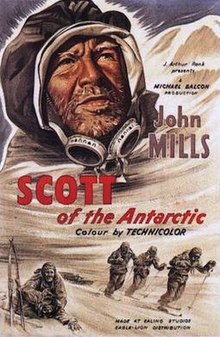Scott of the Antarctic (1948 film)
| Scott of the Antarctic | |
|---|---|

Original cinema poster
|
|
| Directed by | Charles Frend |
| Produced by | Michael Balcon |
| Written by | Walter Meade Ivor Montagu Mary Hayley Bell |
| Starring |
John Mills James Robertson Justice Barry Letts |
| Music by | Ralph Vaughan Williams |
|
Production
company |
|
| Distributed by | GDF (UK) |
|
Release date
|
|
|
Running time
|
111 min. |
| Country | United Kingdom |
| Language | English |
Scott of the Antarctic is a 1948 technicolour film which depicts Robert Falcon Scott's ill-fated Terra Nova Expedition and his attempt to be the first to reach the South Pole in Antarctica. John Mills played Scott, with a supporting cast which included James Robertson Justice, Derek Bond, Kenneth More, John Gregson, Barry Letts and Christopher Lee.
Produced by Ealing Studios, the film was directed by Charles Frend and largely shot at the studios, with some landscape and glacier exteriors shot in the Swiss Alps and in Norway; no actual scenes were made in Antarctica, though some pre-war from Graham Land may have been used. The film was made in Technicolor. The script was by Ivor Montagu, Walter Meade and the novelist Mary Hayley Bell, Mills' wife. The film is also known for its score by Ralph Vaughan Williams that was later reworked into his Sinfonia antartica.
The film is largely faithful to the real events of the ill-fated polar trek, with emphasis on the stoic character of Scott and the hostility of the Antarctic environment.
Captain Scott is given the men, but not the funds, to go on a second expedition to the Antarctic. As his wife works on a bust of him, she tells him that she's "not the least jealous" that he's going to the Antarctic again. The wife of Dr. E. A. Wilson, whom Scott hopes to recruit, is much less enthusiastic, but Wilson agrees to go on condition it is a scientific expedition. Scott also visits Fridtjof Nansen, who insists that a polar expedition must use only dogs, not machines or horses. Scott goes on a fundraising campaign, with mixed results, finding scepticism among Liverpool businessmen, but enthusiasm among schoolchildren who fund the sledge dogs. With the help of a government grant he finally manages to raise enough money to finance the expedition.
...
Wikipedia
